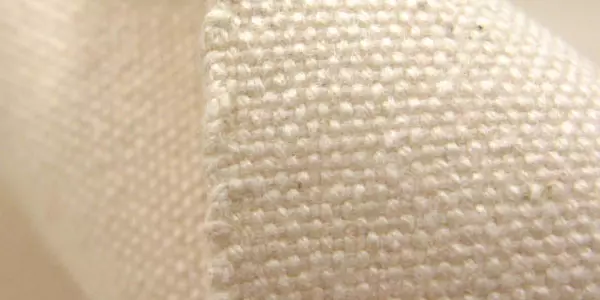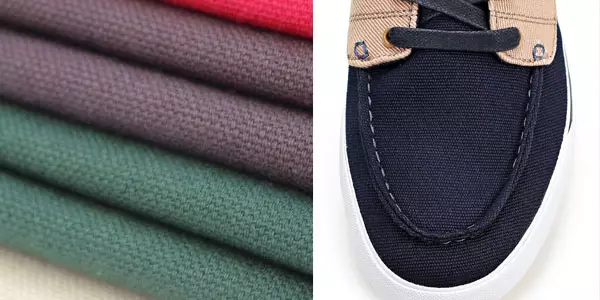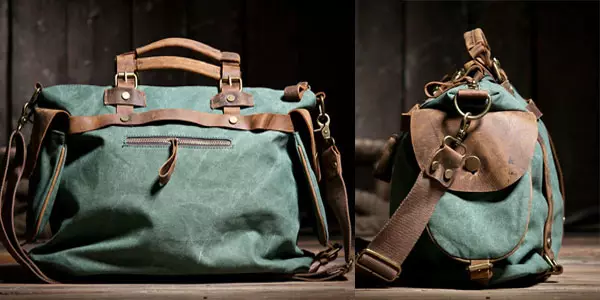Textiles called Canvas began to be issued relatively recently and is still a rarity in our market. Despite the consonance with the name "Kanva", this is a completely different type of material - both in composition and structure and for its intended purpose. They only have a fabric pattern with a characteristic major weave.
What is Canvas?

In the antique Mediterranean, the carriage fabric was made of hemp cannon, for the strength of the wax impregnated, which was called Cannabis - derived from the name of hemp. Note that textiles from the fibers of this plant was widely used for various needs many nations, including the Slavs, and the hemp was almost mandatory belonging to the peasant farm.
All species of such materials were distinguished by a clear linen pattern of weave, as well as strength and durability, although they were quite rude. Over time, the manufacturing technology of the canas has changed, but the fabric that can be called canvas (denoting this concept of any canvas), did not disappear from use. It was sewed with clothes, mostly labor - it is believed that the first trousers that the Lewis company known subsequently be released was made from hemp canopy. This material was used for packaging of goods, sewing bags, bags, covers, furniture manufacturing, especially unfolding.
The technology of production of Canvas also did not stand in place. A rare fabric of thin cotton or linen threads has become widely used to use for countable embroidery, and gained distribution called "Kanva", which has become applied even in a figurative value as the basis of something. Finally, in the technology of manufacturing this textile, they made their share of the development of polymer fibers. Modern fabric cannas resembles its predecessor only by appearance - with its composition, structure and methods of obtaining are completely different, and the strength is much superior to the natural prototype.
Article on the topic: Male weaving for men: bracelets do it yourself with photos and videos
Modern canvas - what is he?
The fabric coming on sale under this title may contain in its composition:
- cotton;
- nylon;
- polyester;
- Teflon impregnation.

The main difference is that this material, although it looks like a traditional sailing canvas, is manufactured using velor weave technology and has a two-layer structure:
- The lower layer (base) consists of cotton (35%) and polyester (65%);
- The top layer is entirely synthetic, most often it contains polyester, sometimes with the additive of nylon (up to 15%).
Due to the special technology of weaving, the canvas has very greater durability and durability, and its appearance exactly reproduces the sail of the former times.
Additional Teflon impregnation does not interfere with gas exchange, but it creates effective protection for the penetration of dust, moisture and the accumulation of dirt. The main advantages of this innovation fabric are:
- unique wear resistance;
- "Breathable" properties;
- Softness peculiar to natural fibers;
- resistance to deformations, no shrinkage;
- water repellent and dirt-repellent properties;
- strength of fibers that do not format;
- Easy operation and care.
If natural canvas has had a grayish color, peculiar to cannol fibers, then the modern modification of this tissue allows you to use resistant bright dyes and create original images using thermal printing. At the same time, the fabric of a natural shade continues to remain very popular, which is practically not worn, and losing his novelty, it becomes only more stylish. It is ideal for creating images and interiors in the environmental, Mediterranean and other relevant styles.
High performance properties of this material contribute to the expansion of demand for it. One of the main directions where the canvas is used is the manufacture of furniture and interior decoration. In demand is this fabric also for army and sports form (shoes, clothing) and ammunition (backpacks, bags, shields for knees and elbows). Analogue of the cans is widely used for uniform and corporate clothing.
Article on the topic: Beaded products for beginners with their own hands with diagrams and photos
Bags and backpacks from this material are used by special demand, which, despite its subtlety, are very durable and practical . It is argued that such a backpack becomes slower than its owner, despite the fact that Canvas is relatively inexpensive. However, it must be remembered that some sellers may refer to the "canvas" category, which includes not only canvas, but also tarpaulin, canvas, cotton and blended fabric, etc., so when buying it is necessary to specify the name on Original language (canvas) and fabric composition.
Almost no care

Care for things from the seasons of the new generation is very simple. The only precaution that should be observed - not to damage the Teflon impregnation, since its destruction will worsen many protective qualities of this tissue. If a spot appeared on the product, it is easy to wash it with a sponge, moistened with water or soapy solution. With long-term operation, both in the outdoors and indoors, the product from Canvas should be periodically shaking or vacuuming (using only a soft brush).
The washing is carried out if necessary, using economical machine mode and warm water for this. This fabric will instantly dry and does not form a chance. If there is a desire or the need to smooth it, then you should use a pair or cold iron stream.
